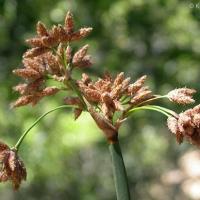Tule
Schoenoplectus acutus, Schoenoplectus lacustris
Schoenoplectus acutus, commonly known as hardstem bulrush, tule, or common tule, is a tall, perennial plant that belongs to the Cyperaceae family. It is native to wetland habitats in North America, Europe, Asia, and northern Africa. Tules are known for their prominent and dense growth in wetlands and are ecologically significant. Here is a description of Schoenoplectus acutus:
Appearance:
- Hardstem bulrush is a tall, grass-like plant that can grow up to 3 meters (about 10 feet) in height.
- It has long, slender, and cylindrical stems with sharp, triangular cross-sections.
- The leaves are reduced to bladeless sheaths that wrap around the stem.
- The flowers of tules are small and inconspicuous, usually arranged in dense clusters at the ends of the stems.
- The plant often forms dense stands, which provide habitat and nesting sites for various wildlife.
Habitat:
- Tules thrive in a variety of wetland habitats, including marshes, swamps, and the margins of lakes and rivers.
- They can grow in standing water, mud, or saturated soils and are well adapted to fluctuating water levels.
Lifecycle:
- Hardstem bulrush is a perennial plant, meaning it can persist and continue growing for multiple years.
- It reproduces both by seed and vegetatively, with rhizomes that help it spread.
Ecological Role:
- Tules play a crucial role in wetland ecosystems. They help stabilize soils, provide habitat for aquatic and wetland wildlife, and serve as a protective buffer against erosion.
Cultural Uses:
- Historically, indigenous peoples in North America have used tules for various purposes, including as building materials for traditional homes, such as thatch for shelters.
Schoenoplectus acutus is an important and characteristic plant of wetland environments, providing habitat and ecological benefits for various species. Its role in stabilizing wetland soils and providing shelter for wildlife makes it a valuable component of these ecosystems.








